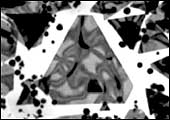 |
| Tiny plans: Rahul Patwardhan of Indiaco
(left) Powerpoints his nanotech vision. His team looks on |
It
should be easy to find the technology incubator that hosted an international
conference on nanotechnology earlier this year in Pune. It isn't:
searching for #214, Lal Bahadur Shastri Marg in Pune's Navi Peth
is an ordeal. There are no numbers on most buildings in the shabby,
crowded, nondescript, street; requests for directions at std booths
or small restaurants are met with a blank stare. Finally, remembering
some instructions received over the phone, this writer asks for
Mazdoor Hadda and is directed to a Lal Bahadur Shastri statue near
Dhandekar pul (bridge). Casual labourers are squatting on the roadside
hoping to get a day's work. There are small trucks and tempos parked
on both sides of the road.
At the corner is a building with sloppily done
signage, which reads Indiaco. The broad stairs that lead up are
dirty with slush. The building has crude steel windows of the housing-board
variety. The reception is not air-conditioned. The soft board is
a patchwork of faded blue chart paper, something straight out of
a kindergarten school in an underprivileged neighbourhood. After
a 10-minute wait on a sofa with more-than-well-worn cushions, I
am ushered into the basement. This room is air-conditioned (thankfully),
boasts a functional conference table on one side, and a portrait
of Narayanrao Gangadharrao Patwardhan, erstwhile Prince of Miraj,
and great grandfather of Ramachandrarao Gangadharrao 'Rahul' Patwardhan
on the wall. Nothing in the room lets you into the fact that Indiaco
is a happening incubator, and that it is from here that Rahul Patwardhan
operates a technology network.
Not much later, Patwardhan, a hazel-eyed, small-built
man breezes in, sets up his laptop, barely waits for his team of
four to be seated and begins a presentation on Indiaco, a school
for start-ups. "We have coached 52 start-ups, 19 have graduated,
five have made financial exits (one IPO and four acquisitions),
and 95 per cent of all our start-ups are cash-positive. We have
a network of 80 advisors who spend eight to 10 hours with a company
a month. We are located in India, the US, Australia, Poland, Singapore
and Chile." Slides and more slides run on in a similar vein.
Boy, this prince wields a mean mouse! He graphs and annotates on
the projection, with a Powerpoint pen that has been set to red.
His team is extremely comfortable-no complexes about hierarchies
or royalty here- and pitches in often. Kunal Walia, an aggressive
young man who joined Indiaco when his start-up Artemis, an incubatee
company folded up, often finishes or emphasises what Patwardhan
begins.
So what will Indiaco do for start-ups? "We
will push the car for an entrepreneur if he has to reach a meeting
in time," is Patwardhan's comeback, his face crinkling into
a characteristic laugh. Indiaco adopts (for want of a better word)
entrepreneurs, provides them infrastructure (if needed), accounting
norms, hr and other 'back-ends', and everything else required to
translate a big idea into a small company.
 |
| Room No. 293: NCL scientist Murali Sastry
in his small clean room in the lab where he makes filmsof gold
nanoparticles |
Indiaco also uses its network to find alpha
and beta customers for the company and create a deal flow for VCs.
"Rahul is extremely well networked. I was able to set up a
company in the US sitting right here in India. He put us through
to attorneys, tax guys and so on. He is always logged to the msn
messenger. That is how hands-on he is," says Vishal Gondal,
the 25-year-old CEO of the Mumbai-based Indiagames, a gaming company,
who eventually decided against a US office.
So far, so good. Now, on to the story: Patwardhan's
latest obsession is nanotechnology. He is launching an initiative
called Indianano with a scientist who cannot be named just yet as
CEO. "We are going to have 12 nanotech companies in the next
18 months. We will ourselves invest in three of them."
The Nanotech Wave
Nano stands for a one-billionth fraction and
nanotechnology is the science of working with materials at this
scale (atomic or molecular) or creating new material or machines,
a few atoms at a time. From microscopic devices to futuristic materials
to miniature circuits, nanotechnology holds the promise of the next
big thing. "What happened to the tennis racket when it changed
from wood to graphite? Now imagine what will happen if we can create
a material that is half the weight of the graphite and is 10-times
stronger than steel," says Patwardhan. Great, but does he have
something specific in mind? "Yes, we have identified calcium
carbonate nanoparticles that can make PVC plastics stronger."
Now, Indiaco plans to identify Indian corporates interested in the
technology.
Is that the only product on offer? No, Indiaco
has identified a nanotech company out of University of Southern
California that makes better fuel cells. These last longer, occupy
less space, and are bio-degradable. This company has investments
from a well-known Sandhill VC, but neither the company nor the vc
can be named. Indiaco plans to find Indian customers interested
in this technology too.
Will any be? Yes. "I'm leveraging four
or five hundred years of goodwill that my family has generated to
get openings," is the answer. The royal family of Miraj has
donated land and money to several large entrepreneurs (now, now,
don't look for names; royalty never lists instances of generosity)
in the past, even ran a bank and power station, which supplied electricity
to all the sugar mills in the Miraj-Sangli area. Does he use his
princely card often? "I use my discretion. I had to call up
Ashuman Ruia (of Essar) for one of my start-ups and I did."
 |
| Nanotubes: Calcium carbonate can separate
protiens |
 |
| Triangular gold: Four-nanometre-thick
particles can pierce cell membrances |
 |
| Nanostar: Self-assembling calcium carbonate
nanoparticles |
By now a visitor has arrived. Patwardhan, deft
networker that he is, calls him in. "Adu come on in and meet
my guest." Adu is young (most people in the prince's office
are), educated in the US, and his card reads Aditya Pitie, Director,
Agni Solar Systems. He also happens to be the nephew of Vinay Rai
of the Usha Group. "You were asking me if Indian companies
would be interested in better fuel cells, here's someone who could
be interested," says Patwardhan.
The prince's networking isn't restricted to
India. The world has always been his oyster. Even while he was a
student at Pune, Patwardhan used to regularly accompany his father
to the US, and his family has a house in London. He has been an
advisor to The New Enterprise network, which incidentally was where
eBay was born. And he is not shy about dropping names. The Economic
Development Board of Singapore is due to visit over the weekend,
he tells me.
Why is he doing all this? "Well, we should
create intellectual property here, drive the world market from here.
We missed the IT wave. We missed the biotech wave. Our pharma companies
should have created patents seven years ago and gone to the world
market now. India has to create a nanotech wave. Each company will
create many offshoots." Phew!
But how much nanotech work is being done in
India? "We have identified at least 30 products across laboratories
in India. There are at least 550 people working on it. These ideas
have to first be patented, then productised and then made manufacturable."
How futuristic are nanotech-based products?
How long term will investments in these companies be? How will they
sustain themselves till then? The Powerpoint pen flies on slide.
The x-axis is the interval in years. The pen stops between three
and five years. That is when these companies will get funded. The
products are five to seven years away. Till then the companies will
sustain themselves with contract research. Are there VCs in India
who will want to fund these companies already? "There is one
such project in stealth mode. Rahul gets into bed very early. We
help scale up," says Vivek Sekhar of 2iCapital, which has funded
several technology companies none of which, he claims, are into
business process outsourcing or plain it services.
Is All This For Real?
All this smacks too much of dotcom era slideware.
If there is this kind of optimism, it should be validated easily.
The National Chemical Laboratory, home to scientist Murali Sastry-he
won the Bhatnagar award (named after the first Director-General
of the Centre for Scientific and Industrial Research) for nanotech
just this year-is just a 20-minute rickshaw ride away from Indiaco
in Pune. If Patwardhan has ambitious plans, surely someone so close
would have heard of it?
Sastry is a tall, strapping dapperly dressed
man who dominates room 293-it has a generous-shower-cubicle sized
clean room facility and is swarming with white-coated students.
Ask him if an incubator for nanotech makes sense and a rhetorical
question follows. "Isn't that the model followed overseas?"
In fact, the professor has been thinking on those lines himself.
Surprise, surprise
| It will be three to five
years before the companies get funded. The products are five
to seven years away. Till then the companies will sustain themselves
with contract research |
The savvy Sastry offers a quick tour of his
lab. The clean room houses a Langmuir machine that can make thin
films of nanoparticles. The professor holds up a purple colour slide,
a film of gold nanoparticles (four nanometres or 2,000 atoms of
gold). Gold particles, when charged and floated on any solution
will cling on to small particles. This can be used in the pharmaceutical
industry: Gold, after all, is bio-compatible, and can pass through
cell membranes . What kind of drugs could be administered with the
aid of the precious metal, I wonder. "We have a lot of tricks
up our sleeve. We could charge the gold particles positive or negative.
The drugs could be proteins, hormones, insulin...and methods of
delivery could be novel too," chuckles the prof. Room 238 is
where students, in groups are synthesising gold particles using
biological methods. Sastry picks up a flat-bottomed glass with a
colourful liquid. That has gold particles synthesised using lemon
grass, which has chemicals to reduce the metal ion. This is the
green chemistry approach.
The professor's 15-odd PhD students who come
from diverse disciplines like biotech, physics, chemistry and molecular
biology are working on other nanoparticles too. Cadmium sulphide,
a semi-conductor, barium sulphate and calcium carbonate, both minerals
are some names he mentions. Sastry just chanced upon nanotechnology
in 1995 when, after winning the CSIR young scientist award he was
allowed to set up his own lab with a princely grant of Rs 2 lakh
a year. The lab-about Rs 1.6 crore has been invested in it over
the years-now has two US patents to its credit and has filed for
six more. Ummm.
Is there a lot of work in nanotechnology being
done in India? "C.N.R. Rao's-he is the head of the government's
nanotech initiative-laboratory at the Jawaharlal Nehru Center in
Bangalore is working on carbon nanotubes, nanoassembly and synthesis.
Delhi U's Amarnath Maitra is working on drug immobilisation, has
even licensed some technology to Dabur." Could there be about
30 products across all the labs in the country? "A good estimate,"
says Sastry. The professor's verdict matches the prince's.
|
